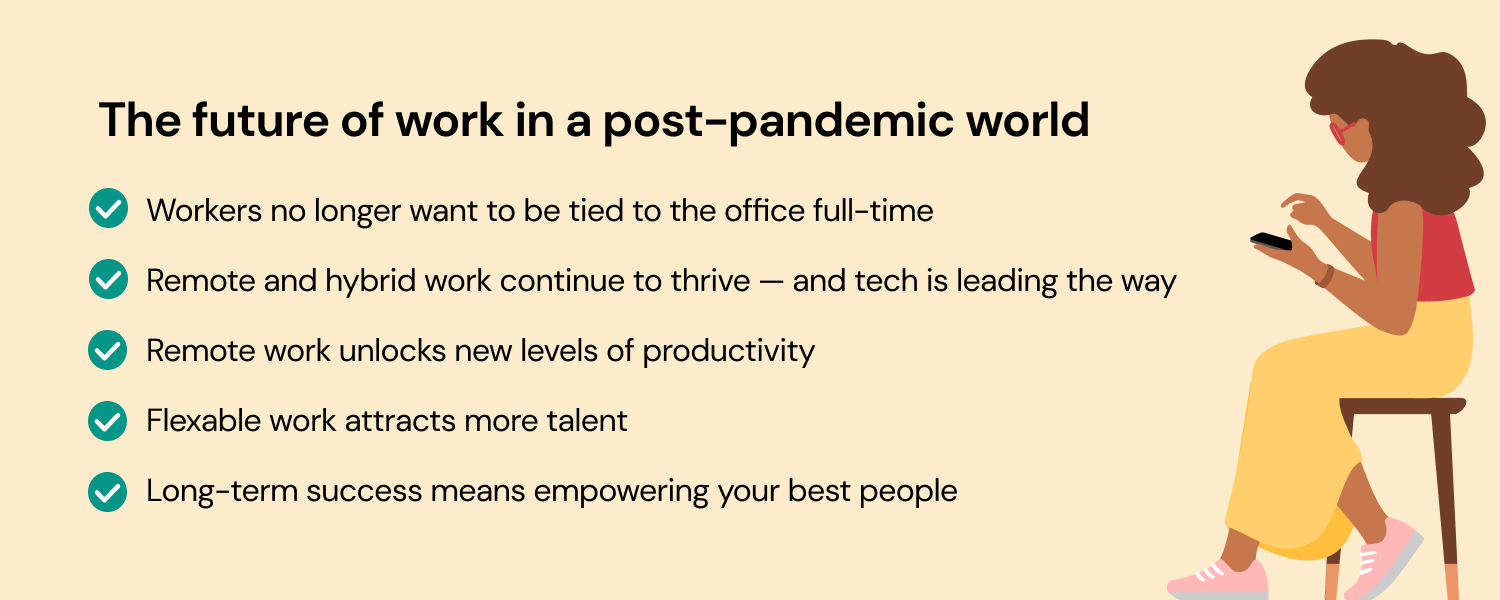In this article:
-
The future of work in a post-pandemic world
- 1. Workers no longer want to be tied to the office full-time
- 2. Remote and hybrid work continue to thrive — and tech is leading the way
- The shift to hybrid work may run into some growing pains
- 3. Remote work unlocks new levels of productivity
- 4. Flexible work attracts more talent
- 5. Long-term success means empowering your best people
The future of work in a post-pandemic world
It’s been over two years since the pandemic first started, and we’re now seeing employees return to the office. This disruptive event has fundamentally changed the workplace as we know it.
And yet, the business world continues to push forward, thanks in large part to advances in workplace communication tools and technologies, as well as shifting attitudes toward work from employees.
What we know is clear: there’s been a major shift in the way we view and approach work — and companies of all sizes are taking notice.
One look at the numbers is all the proof you need to conclude work will never be the same again, even as companies welcome their teams back to the office.
So, what are the main trends transforming the workplace? What’s driving them? And with the “Great Return to Work,” what does the future hold for distributed and flexible work models?
1. Workers no longer want to be tied to the office full-time
Even though offices are open again, it’s safe to say the majority of employees aren’t overly enthusiastic about the idea of physically returning to work. In fact, business intelligence firm Morning Consult found three out of five surveyed tech sector employees didn’t want to return to the office full-time.
What’s motivating this change? We know it’s not a desire to resign from employment entirely. Another report shows a third of these tech workers were “never” interested in resigning, which was a sentiment shared even before the pandemic hit.
The implication here is employees want remote or hybrid work — especially among office workers. By changing gears this way, remote and hybrid workers enjoy:
-
Saving on commuting time and costs
-
More control over personal and professional schedules
-
A healthier work-life balance
The widespread use of remote working technologies like cloud communications (think Microsoft Teams for example) has also enabled this change, by allowing companies and employees to stay productive while working remotely.
If you’ve ever heard of the term “Great Resignation,” you’re probably aware how other industries have struggled getting employees to come back at all. Many experts believe employee burn-out and a lack of a good work-life balance contributed to this phenomenon. The solution? Hybrid and remote working styles!
2. Remote and hybrid work continue to thrive — and tech is leading the way
Is there any tangible evidence this shift to hybrid work is happening? Let’s see what the stats have to say.
The same 2022 Morning Consult report shows us some eye-opening insights into how the pandemic has changed the nature of the workplace in tech:
- Almost 50% of tech workers are fully remote, compared to only 22% before COVID-19.
- The vast majority (85%) of tech workers are either fully remote or engaging in a hybrid model.
- 90% of those employees have the option to work remotely at least part-time.
Current world events and the introduction of remote work technologies have shifted the focus to more flexible hybrid options.
This trend is actually the reason why the tech sector wasn’t impacted as much by the Great Resignation. As early adopters of hybrid work, tech companies have empowered their employees to work on their own terms — and other industries can learn from their example as it paves the way for future workplaces.
The shift to hybrid work may run into some growing pains

Just like any major change, the transition to hybrid work comes with challenges.
A 2021 survey conducted by Deloitte sheds some light onto what the most pressing concerns were:
-
32% of employees were mainly concerned about “maintaining company culture”
-
26% worried about the impact on performance
-
19% thought collaboration would be a hurdle
-
13% wanted to make sure remote and on-site employees would be treated fairly
It’s clear many fear a lack of proper communication between remote and on-site workers. To promote a healthy hybrid work environment and prevent any issues regarding performance, company culture, or unfair treatment, businesses need to provide the communication tools necessary for employees to collaborate smoothly and efficiently, no matter where they are. They also need to explore how they can keep employees dialed into the culture they’ve worked so hard to build.
3. Remote work unlocks new levels of productivity
The advantages of hybrid and remote work go beyond just making employees happy. The benefits spread both onto the companies and the society around them.
A 2022 survey by the University of Chicago received responses from 10,000 employees, indicating they felt just as productive working from home as they were in the office. At least 30% of them even thought remote work was more productive.
Eliminating the need to commute to work every day also helps build a more eco-friendly business. The United States Environmental Protection Agency predicts 28% of greenhouse gases come from transportation, and The Census Bureau reports 86% of commuters drive their own cars to work.
4. Flexible work attracts more talent
Don’t think hybrid work is merely a fad or a flash in the pan! Studies tracking employees’ post-pandemic behavior have shown this new model of work has serious staying power.
For instance, 60% of employees believe they’re more likely to apply for a job when it offers a remote option. This trend is particularly strong amongst the younger generation (Generation Z in this case). Employers can and should boast remote work options as a selling point when searching for new talent.
What does this all mean? It seems by the year 2025, 36.2 million workers will be remote — that’s an 87% increase since the pre-pandemic era and 22% of all Americans. Mark Zuckerberg himself said in an NBC news report that half of Facebook may be remote by 2030.
One thing is clear: companies who encourage flexible work can tap into the global talent pool and snap the best candidates from competitors who reject flexible work models.
5. Long-term success means empowering your best people
More and more employees are practically scrambling to find flexible hybrid or remote work. Very few want to return to a fully in-person office environment like in the pre-pandemic days.
Why? Because people want a healthier work-life balance, more control over personal schedules, and to remove the need to commute entirely. Meanwhile, businesses can enjoy higher productivity, a reduced environmental impact, and cost-savings on office leases.
So, how can you turn flexible work into a differentiator for your company? It starts with having the communication and collaboration tools in place for a hybrid workplace. Talk to an expert at Sinch and see how our smart voice and customer experience solutions can transform the way you connect and collaborate in the hybrid workplace.



